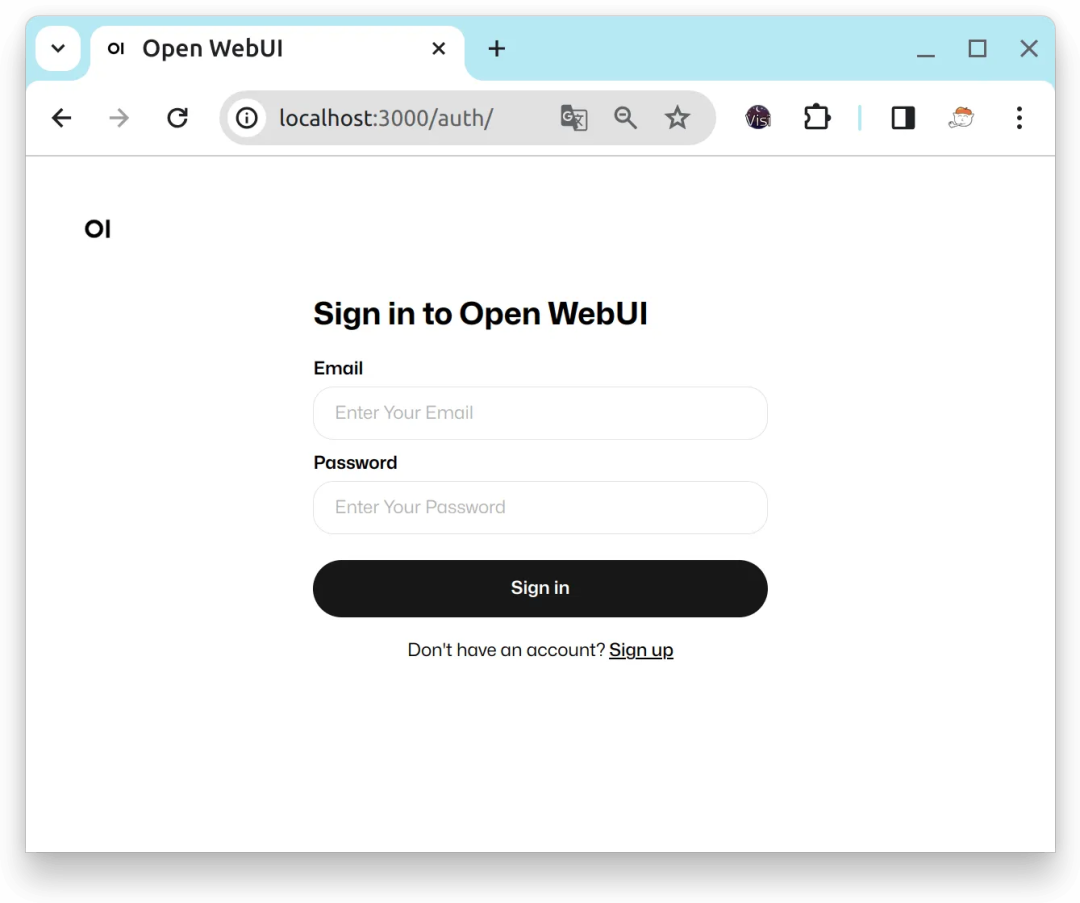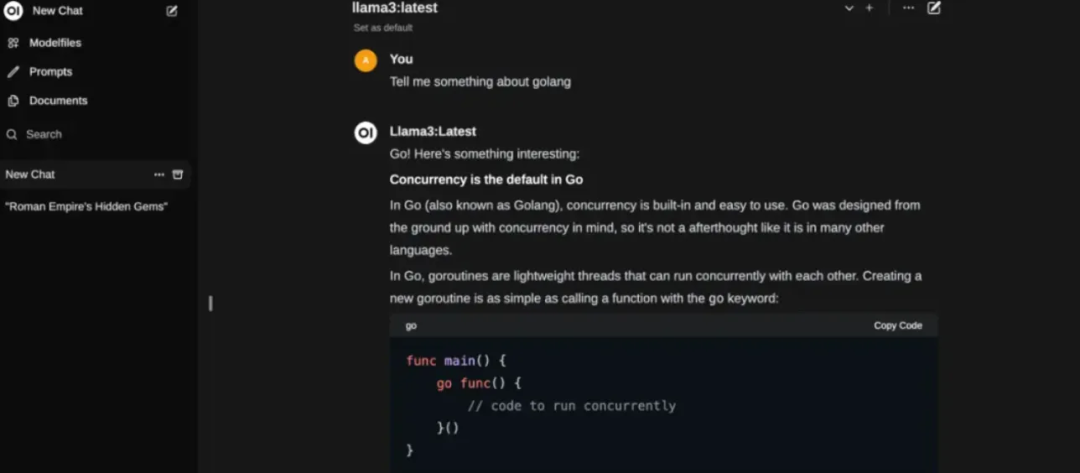大家好,2024年4月,Meta公司开源了Llama 3 AI模型,迅速在AI社区引起轰动。紧接着,Ollama工具宣布支持Llama 3,为本地部署大型模型提供了极大的便利。
本文将介绍如何利用Ollama工具,实现Llama 3–8B模型的本地部署与应用,以及通过Open WebUI进行模型交互的方法。
1.安装Ollama
使用“curl | sh”,可以一键下载并安装到本地:
$curl -fsSL https://ollama.com/install.sh | sh >>> Downloading ollama... ######################################################################## 100.0% >>> Installing ollama to /usr/local/bin... >>> Creating ollama user... >>> Adding ollama user to video group... >>> Adding current user to ollama group... >>> Creating ollama systemd service... >>> Enabling and starting ollama service... Created symlink from /etc/systemd/system/default.target.wants/ollama.service to /etc/systemd/system/ollama.service. >>> The Ollama API is now available at 127.0.0.1:11434. >>> Install complete. Run "ollama" from the command line. WARNING: No NVIDIA/AMD GPU detected. Ollama will run in CPU-only mode. 可以看到,下载后Ollama启动了一个ollama系统服务。这项服务是Ollama的核心API服务,并且它驻留在内存中。通过systemctl确认服务的运行状态:
$systemctl status ollama ● ollama.service - Ollama Service Loaded: loaded (/etc/systemd/system/ollama.service; enabled; vendor preset: disabled) Active: active (running) since 一 2024-04-22 17:51:18 CST; 11h ago Main PID: 9576 (ollama) Tasks: 22 Memory: 463.5M CGroup: /system.slice/ollama.service └─9576 /usr/local/bin/ollama serve 另外,这里对Ollama的systemd单元文件做了一些修改。修改了Environment的值,并添加了“OLLAMA_HOST=0.0.0.0”,以便在容器中运行的OpenWebUI能够访问Ollama API服务:
# cat /etc/systemd/system/ollama.service [Unit] Description=Ollama Service After=network-online.target [Service] ExecStart=/usr/local/bin/ollama serve User=ollama Group=ollama Restart=always RestartSec=3 Environment="PATH=/root/.cargo/bin:/usr/local/cmake/bin:/usr/local/bin:.:/root/.bin/go1.21.4/bin:/root/go/bin:/usr/local/sbin:/usr/local/bin:/usr/sbin:/usr/bin:/root/bin" "OLLAMA_HOST=0.0.0.0" [Install] WantedBy=default.target 修改后,执行以下命令使其生效:
$systemctl daemon-reload $systemctl restart ollama 2.下载并运行大模型
Ollama支持一键下载和运行模型。
这里用的是一台16/32GB的云虚拟机,但没有GPU。所以使用的是经过聊天/对话微调的Llama3-8B指令模型。只需使用以下命令快速下载并运行模型(4位量化):
$ollama run llama3 pulling manifest pulling 00e1317cbf74... 0% ▕ ▏ 0 B/4.7 GB pulling 00e1317cbf74... 7% ▕█ ▏ 331 MB/4.7 GB 34 MB/s 2m3s^C pulling manifest pulling manifest pulling manifest pulling manifest pulling 00e1317cbf74... 61% ▕█████████ ▏ 2.8 GB/4.7 GB 21 MB/s 1m23s^C ... ... 下载和执行成功后,命令行将等待你的问题输入。我们可以随意输入一个关于Go的问题。以下是输出结果:
$ollama run llama3 >>> could you tell me something about golang language? Go! Here are some interesting facts and features about the Go programming language: **What is Go?** Go, also known as Golang, is a statically typed, compiled, and designed to be concurrent and garbage-collected language. It was developed by Google in 2009. **Key Features:** 1. **Concurrency**: Go has built-in concurrency support through goroutines (lightweight threads) and channels (communication mechanisms). This makes it easy to write concurrent programs. 2. **Garbage Collection**: Go has a automatic garbage collector, which frees developers from worrying about memory management. 3. **Static Typing**: Go is statically typed, meaning that the type system checks the types of variables at compile time, preventing type-related errors at runtime. 4. **Simple Syntax**: Go's syntax is designed to be simple and easy to read. It has a minimalistic approach to programming language design. ... ... 推理速度大约是每秒5到6个token,这个速度是可以接受的,但这个过程对CPU资源的消耗相当大:

除了可以通过命令行与Ollama API服务交互外,还可以使用Ollama的RESTful API:
$curl http://localhost:11434/api/generate -d '{ > "model": "llama3", > "prompt":"Why is the sky blue?" > }' {"model":"llama3","created_at":"2024-04-22T07:02:36.394785618Z","response":"The","done":false} {"model":"llama3","created_at":"2024-04-22T07:02:36.564938841Z","response":" color","done":false} {"model":"llama3","created_at":"2024-04-22T07:02:36.745215652Z","response":" of","done":false} {"model":"llama3","created_at":"2024-04-22T07:02:36.926111842Z","response":" the","done":false} {"model":"llama3","created_at":"2024-04-22T07:02:37.107460031Z","response":" sky","done":false} {"model":"llama3","created_at":"2024-04-22T07:02:37.287201658Z","response":" can","done":false} {"model":"llama3","created_at":"2024-04-22T07:02:37.468517901Z","response":" vary","done":false} {"model":"llama3","created_at":"2024-04-22T07:02:37.649011829Z","response":" depending","done":false} {"model":"llama3","created_at":"2024-04-22T07:02:37.789353456Z","response":" on","done":false} {"model":"llama3","created_at":"2024-04-22T07:02:37.969236546Z","response":" the","done":false} {"model":"llama3","created_at":"2024-04-22T07:02:38.15172159Z","response":" time","done":false} {"model":"llama3","created_at":"2024-04-22T07:02:38.333323271Z","response":" of","done":false} {"model":"llama3","created_at":"2024-04-22T07:02:38.514564929Z","response":" day","done":false} {"model":"llama3","created_at":"2024-04-22T07:02:38.693824676Z","response":",","done":false} ... ... 此外,可以在日常生活中使用大型模型的方式还有通过Web UI进行交互,有许多Web和桌面项目支持Ollama API。在这里选择了Open WebUI,它是从Ollama WebUI发展而来的。
3.使用Open WebUI与大模型交互
体验Open WebUI最快的方式当然是使用容器安装,但是官方镜像站点ghcr.io/open-webui/open-webui:main下载速度太慢,这里在Docker Hub上找到了一个个人镜像。以下是在本地安装Open WebUI的命令:
$docker run -d -p 13000:8080 --add-host=host.docker.internal:host-gateway -v open-webui:/app/backend/data -e OLLAMA_BASE_URL=http://host.docker.internal:11434 --name open-webui --restart always dyrnq/open-webui:main 容器启动后,通过访问主机上的13000端口来打开Open WebUI页面:

Open WebUI会把第一个注册的用户视为管理员用户。注册并登录后,进入首页,在选择模型后,可以输入问题并与由Ollama部署的Llama3模型进行对话:

